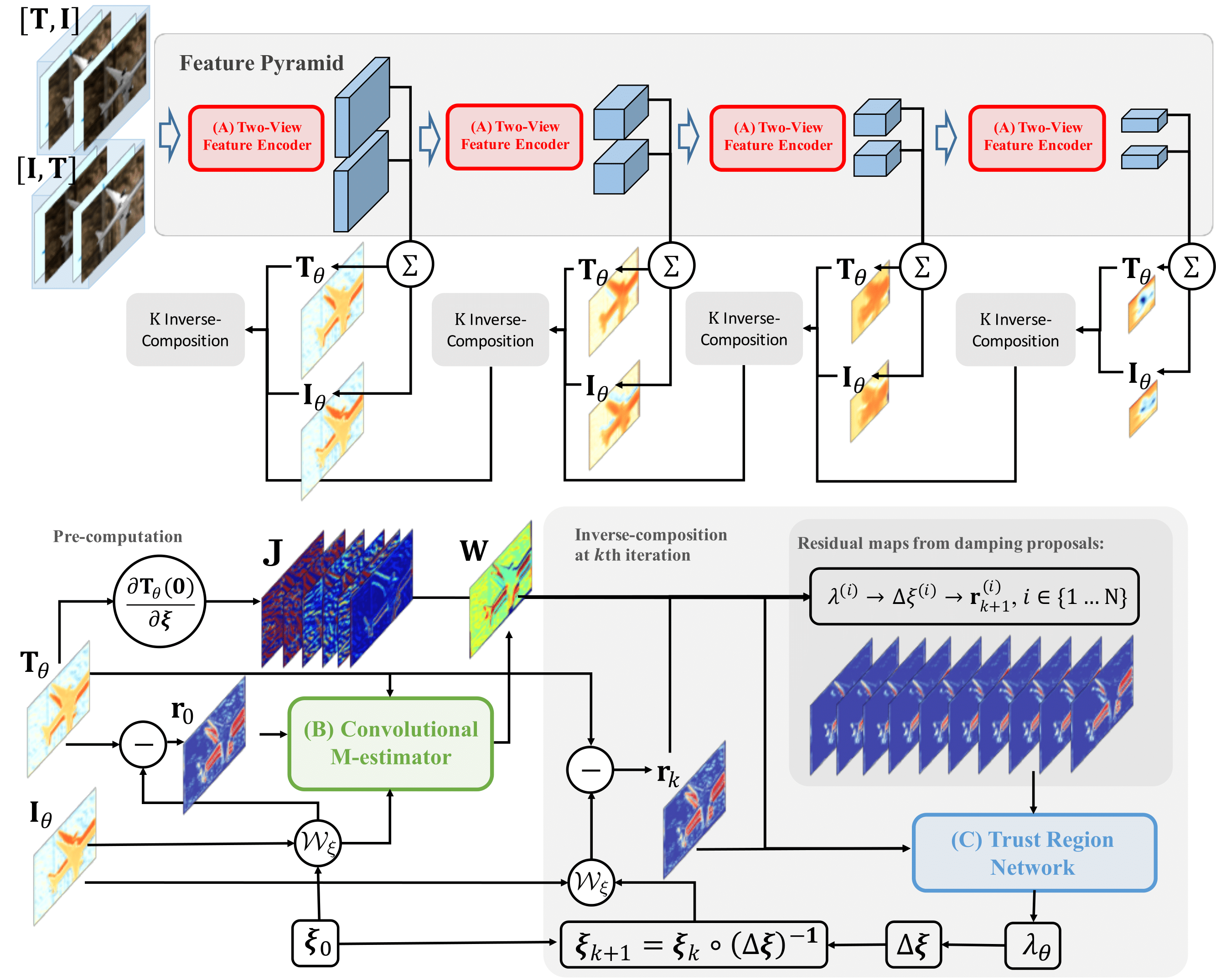This is the official repository of our CVPR 2019 paper:
Taking a Deeper Look at the Inverse Compositional Algorithm, Zhaoyang Lv, Frank Dellaert, James M. Rehg, Andreas Geiger, CVPR 2019
@inproceedings{Lv19cvpr,
title = {Taking a Deeper Look at the Inverse Compositional Algorithm},
author = {Lv, Zhaoyang and Dellaert, Frank and Rehg, James and Geiger, Andreas},
booktitle = {CVPR},
year = {2019}
}Please cite the paper if you use the provided code in your research.
- Zhaoyang Lv, Georgia Institute of Technology (Ph.D. student), Max Planck Institute (Alumni)
- Frank Dellaert, Georgia Institute of Technology
- James M. Rehg, Georgia Institute of Technology
- Andreas Geiger, Max Planck Institute, University of Tuebingen
Please drop me an email if you have any questions regarding this project.
Zhaoyang Lv (zhaoyang.lv@gatech.edu, lvzhaoyang1990@gmail.com)
The code is developed using Pytorch 1.0, CUDA 9.0, Ubuntu16.04. Pytorch > 1.0 and Cuda > 9.0 were also tested in some machines. If you need to integrate to some code bases which are using Pytorch < 1.0, note that some functions (particularly the matrix inverse operator) are not backward compatible. Contact me if you need some instructions.
You can reproduce the setup by using our anaconda environment configurations
conda env create -f setup/environment.yml
Everytime before you run, activate the environment
conda activate deepICN # the environment name will be (deepICN)
Here is a quick run using pre-trained model on a short TUM trajectory.
python run_example.py
Be careful about the depth reader when you switch to a different dataset, which may use different scaling to the TUM dataset. And this pre-trained model is trained for egocentric-motion estimation using TUM dataset, not for the object-centric motion estimation. These factors may affect the result.
To run the full training and evaluation, please follow the steps below.
TUM RGBD Dataset: Download the dataset from TUM RGBD to '$YOUR_TUM_RGBD_DIR'. Create a symbolic link to the data directory as
ln -s $YOUR_TUM_RGBD_DIR code/data/data_tum
MovingObjects3D Dataset Download the dataset from MovingObjs3D to '$YOUR_MOV_OBJS_3D_DIR'. Create a symbolic link to the data directory as
ln -s $YOUR_MOV_OBJS_3D_DIR code/data/data_objs3D
Train example with TUM RGBD dataset:
python train.py --dataset TUM_RGBD
# or run with the specific setting
python train.py --dataset TUM_RGBD \
--encoder_name ConvRGBD2 \
--mestimator MultiScale2w \
--solver Direct-ResVol \
--keyframes 1,2,4,8 # mixing keyframes subsampled from 1,2,4,8 for training.
To check the full training setting, run the help config as
python train.py --help
Use tensorboard to check the progress during training
tensorboard --log logs/TUM_RGBD --port 8000 # go to localhost:8000 to check the training&validation curve
Train example with MovingObjects3D: All the same as the last one only except changing the dataset name
python train.py --dataset MovingObjs3D \
--keyframes 1,2,4 # mixing keyframes subsampled from 1,2,4 for training
# check the training progress using tensorboard
tensorboard --log logs/MovingObjs3D --port 8001
We will soon release the instructions for the other two datasets used in the paper, data in the BundleFusion and DynamicBundleFusion.
Run the pretrained model: If you have set up the dataset properly with the datasets, you can run the learned model with the checkpoint we provided in the trained model directory
python evaluate.py --dataset TUM_RGBD \
--trajectory fr1/rgbd_dataset_freiburg1_360 \
--encoder_name ConvRGBD2 \
--mestimator MultiScale2w \
--solver Direct-ResVol \
--keyframes 1 \
--checkpoint trained_models/TUM_RGBD_ABC_final.pth.tar
You can substitute the trajectory, the keyframe and the checkpoint file. The training and evaluation share the same config setting. To check the full setting, run the help config as
python evaluate.py --help
Results: The evaluation results will be generated automatically in both '.pkl' and '*.csv' in the folder 'test_results/'.
Run a baseline: This implementation can be simplified to a vanilla Lucas-Kanade method minizing the photometric error without any learnable module. Note that it is not the RGBD VO baseline we report in the paper. It may not be the optimal Lucas-Kanade baseline you want to compared with since we use the same stopping criterion, Gauss-Newton solver within the same framework as our learned model. There is no extra bells and whistles, but it may provide a baseline for you to explore the algorithm in various directions.
python evaluate.py --dataset TUM_RGBD \
--trajectory fr1/rgbd_dataset_freiburg1_360 \
--encoder_name RGB --mestimator None --solve Direct-Nodamping \
--keyframes 1 # optionally 1,2,4,8, etc.
MIT License
Copyright (c) 2019 Zhaoyang Lv, Frank Dellaert, James M. Rehg, Andreas Geiger
Permission is hereby granted, free of charge, to any person obtaining a copy of this software and associated documentation files (the "Software"), to deal in the Software without restriction, including without limitation the rights to use, copy, modify, merge, publish, distribute, sublicense, and/or sell copies of the Software, and to permit persons to whom the Software is furnished to do so, subject to the following conditions:
The above copyright notice and this permission notice shall be included in all copies or substantial portions of the Software.
THE SOFTWARE IS PROVIDED "AS IS", WITHOUT WARRANTY OF ANY KIND, EXPRESS OR IMPLIED, INCLUDING BUT NOT LIMITED TO THE WARRANTIES OF MERCHANTABILITY, FITNESS FOR A PARTICULAR PURPOSE AND NONINFRINGEMENT. IN NO EVENT SHALL THE AUTHORS OR COPYRIGHT HOLDERS BE LIABLE FOR ANY CLAIM, DAMAGES OR OTHER LIABILITY, WHETHER IN AN ACTION OF CONTRACT, TORT OR OTHERWISE, ARISING FROM, OUT OF OR IN CONNECTION WITH THE SOFTWARE OR THE USE OR OTHER DEALINGS IN THE SOFTWARE.
